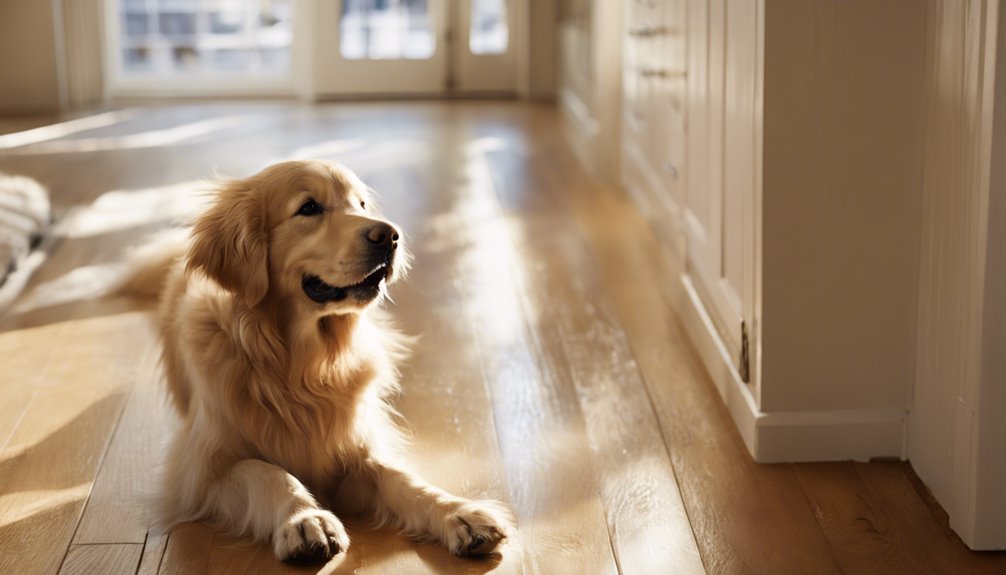If your dog drags its butt on the floor, it might be trying to relieve discomfort. Common culprits include anal gland issues, such as impaction or infection. Allergies, skin irritations, and even parasites can lead to itchiness that prompts scooting. Poor hygiene, like infrequent grooming, can also irritate sensitive areas. Sometimes, foreign objects stuck around the rear can cause irritation too. If this behavior persists, it's a good idea to consult a veterinarian. They can help identify the root cause and recommend treatments. There's much more to reflect on about this behavior that can benefit your furry friend's well-being.
Common Reasons for Scooting
While it may seem amusing when your dog scoots across the floor, it often signals underlying issues that need attention. One common reason for this behavior is dietary factors. If your dog's diet lacks fiber or contains allergens, it can lead to gastrointestinal discomfort, prompting them to seek relief through scooting. Additionally, grooming habits play an essential role. Dogs with long or thick fur may experience irritation or blockage in sensitive areas, making scooting a way to alleviate discomfort. Regular grooming not only keeps their coat healthy but also helps you spot any skin issues early. So, if your pup's scooting becomes frequent, consider evaluating their diet and grooming routine to guarantee they're happy and comfortable.
Anal Gland Issues
When dogs scoot, it often indicates an issue with their anal glands. These glands can become impacted or infected, causing discomfort and prompting your furry friend to drag their rear. Regular anal gland expression is essential to prevent these problems, but sometimes, infections can occur despite your best efforts.
| Issue | Description |
|---|---|
| Anal Gland Impaction | Glands aren't emptying properly, leading to discomfort. |
| Anal Gland Infection | Bacteria invade the glands, causing inflammation and pain. |
| Symptoms | Scooting, licking, swelling, or foul odor. |
| Treatment | Vet visits for expression and possible antibiotics. |
Understanding these issues can help you maintain your dog's comfort and health, ensuring they stay happy and free-spirited.
Allergies and Skin Irritations
If your dog's dragging its butt on the floor, allergies might be at play. Common allergens like pollen, dust mites, and certain foods can lead to skin irritations, causing discomfort. Identifying these irritations early can help you provide relief and prevent further issues.
Common Allergens in Dogs
Allergies in dogs can lead to a range of uncomfortable symptoms, including skin irritations that often prompt them to drag their butt across the floor. Common food allergens like beef, chicken, and dairy can trigger reactions, causing itching and inflammation. Additionally, environmental triggers such as pollen, dust mites, and mold can exacerbate these issues, leading to discomfort. Your dog might also react to certain grooming products or flea treatments, further complicating their skin health. It is crucial to identify these allergens to help your furry friend find relief. By eliminating or managing exposure to these common irritants, you can improve their quality of life and reduce those irritating behaviors, allowing your dog to enjoy a more comfortable, carefree existence.
Identifying Skin Irritations
Identifying skin irritations in dogs can be a challenging task, especially when symptoms like itching and discomfort arise. You'll want to observe your dog closely for any skin irritation symptoms, such as redness, swelling, or excessive scratching. These signs can indicate allergies or irritants that need addressing.
Start by examining your dog's environment and diet to pinpoint potential triggers. Common allergens include certain foods, pollen, or flea bites. Keeping a journal of your dog's activities and symptoms can help in identifying patterns and triggers. If you notice persistent issues, consulting your veterinarian is essential. They can provide further insights and recommend treatments tailored to your dog's needs, ensuring your furry friend finds relief and comfort.
Parasites and Worms
One of the most common reasons dogs drag their butts on the floor is the presence of parasites and worms. These unwelcome guests can cause intense itching and discomfort, prompting your pup to seek relief by scooting. Common offenders include tapeworms and roundworms, which can be diagnosed through a vet visit. To keep your dog healthy, regular parasite prevention is essential. This includes maintaining a consistent deworming schedule and using preventive treatments. If you suspect a worm infestation, don't delay; prompt worm treatment can alleviate your dog's discomfort and prevent further complications. Remember, a little vigilance goes a long way in ensuring your furry friend enjoys a happy, worm-free life!
Discomfort From Foreign Objects
While parasites and worms are common culprits for butt dragging, discomfort from foreign objects can also lead to this behavior. If your dog's scooting seems unusual, it's crucial to conduct a thorough foreign object identification. Things like grass seeds, small stones, or even pieces of toys can become lodged in sensitive areas, causing irritation.
You should perform a discomfort assessment by examining your dog's rear end carefully. Look for signs of redness, swelling, or anything stuck. If you find something, gently remove it, but be cautious not to cause further pain. If the issue persists, consult a veterinarian for professional advice. Addressing foreign object discomfort early can prevent more severe problems and keep your dog feeling happy and free.
Infections or Inflammation
If your dog is dragging its butt on the floor, it could be a sign of infections or inflammation in the anal glands or surrounding tissues. Bacterial infections can lead to discomfort, causing your pup to scoot as a means of relief. Inflammation may arise from various causes, including inflammatory bowel issues, which can also contribute to anal gland problems. When the glands become clogged or infected, they can create significant pain and irritation. It's important to monitor your dog for other symptoms, such as straining during bowel movements or excessive licking around the hindquarters. If you notice any of these signs, consulting your veterinarian is vital to address the underlying issue and restore your dog's comfort and health.
Behavioral Factors
When your dog drags its butt on the floor, it may not just be a physical issue; behavioral factors play an essential role too. This action can stem from itchiness and discomfort, an attempt to grab your attention, or even territorial marking. Understanding these behaviors can help you address the underlying causes effectively.
Itchiness and Discomfort
Dogs often drag their butts on the floor as a result of itchiness and discomfort, which can stem from various underlying issues. If your dog's scratching at their rear, it might be due to itchy skin caused by allergies, parasites, or infections. These discomfort causes can lead to inflammation and irritation, prompting your furry friend to seek relief in the most awkward way possible. Additionally, anal gland problems can result in significant discomfort, pushing them to express their frustration by dragging. It's vital to observe your dog for other signs, such as licking or biting, as these behaviors can indicate deeper issues that require veterinary attention. Addressing the root cause can help restore your dog's comfort and well-being.
Attention-Seeking Behavior
While many people assume that butt-dragging is solely a sign of physical discomfort, it can also be a playful or attention-seeking behavior. Your dog might be using this as one of their attention strategies, hoping to draw your eye or elicit a reaction. If they notice that dragging their butt gets a laugh or some extra pets, they'll likely repeat the behavior. These playful antics can be their way of expressing joy or simply trying to engage with you. It's crucial to differentiate between genuine discomfort and playful behavior. If you're unsure, observing the context and your dog's overall demeanor can help you understand their intentions better. Ultimately, being attentive to your dog's needs fosters a healthier, happier relationship.
Territorial Marking Actions
Some might not realize that butt-dragging can also serve as a form of territorial marking. When dogs drag their behinds along the floor, they can leave behind scent traces that communicate their presence and ownership of a space. This behavior is part of their natural territorial behavior, helping them assert dominance in an area. Just like other forms of scent marking, such as urination or feces, butt-dragging allows dogs to convey messages to other animals. It's a way for them to say, "I'm here, and this is mine." Understanding this can help you appreciate the instinctive drives behind your dog's actions and guide you in providing a suitable environment for their natural behaviors.
Poor Hygiene Practices
When a pet's hygiene isn't properly maintained, it can lead to uncomfortable situations, prompting them to drag their butt on the floor. Poor grooming practices, such as infrequent brushing and neglecting to clean sensitive areas, can result in fecal matter buildup or irritation. This discomfort often drives dogs to seek relief by scooting along surfaces. Using appropriate hygiene products, like pet-safe wipes or regular baths, can help maintain cleanliness. If you're not proactive about your pet's grooming routine, it could lead to skin infections or other health issues. Regularly checking your dog for matting or debris and investing in quality grooming tools is essential. A little effort goes a long way in ensuring your furry friend stays comfortable and happy.
When to See a Veterinarian
If your dog's scooting behavior persists, it's time to consult a veterinarian. Look for signs of discomfort, such as whining or licking, as these can indicate an underlying issue. Additionally, keep an eye out for any unusual stool appearance, which could signal digestive problems that need professional attention.
Persistent Scooting Behavior
Persistent scooting behavior can be a sign of underlying health issues that require prompt attention. If your dog's scooting habits become frequent, it's essential to evaluate the situation. This behavior may indicate problems like anal gland issues, allergies, or intestinal parasites. Ignoring this could lead to discomfort or more severe health concerns.
| Reason for Scooting | Signs to Watch For | Action to Take |
|---|---|---|
| Anal gland issues | Excessive licking | See a veterinarian |
| Allergies | Red, inflamed skin | Consult your vet |
| Parasites | Unusual stool appearance | Schedule an exam |
Signs of Discomfort
Understanding the signs of discomfort in your dog is essential for early intervention and effective treatment. Keep an eye out for discomfort indicators such as excessive whining, panting, or restlessness. If your dog's posture seems hunched or they're avoiding certain activities, these could be signs of pain. Changes in appetite or drinking habits may also signal something's amiss. Additionally, watch for excessive licking or biting at their rear end; these behaviors can indicate irritation or discomfort. If you notice any combination of these signs persisting, it's important to consult your veterinarian. Early detection often leads to better outcomes, so don't hesitate to seek professional advice when you suspect your furry friend is suffering. Your dog deserves to feel their best!
Unusual Stool Appearance
Your dog's health can often be reflected in their stool. If you notice unusual stool types or stool color changes, it's essential to take action. Healthy stool should be firm and brown. However, if you see black, red, or pale stools, it could indicate internal bleeding, dietary issues, or liver problems. Additionally, if the stool is unusually soft, watery, or contains mucus, it might signal gastrointestinal distress or infections. Don't ignore these signs; your dog's comfort and health depend on prompt attention. If you observe any persistent changes in their stool for more than a day or two, it's best to consult your veterinarian. They can provide the necessary evaluations to guarantee your furry friend stays healthy and happy.
Preventive Measures and Care
To keep your dog comfortable and prevent them from dragging their butt on the floor, regular grooming and hygiene are vital. Start by maintaining a consistent grooming routine; this helps remove dirt and debris that can cause irritation. Regularly check and clean your dog's anal area to prevent blockages or infections. Additionally, dietary adjustments play an important role; make certain your dog's diet is high in fiber, which aids in proper digestion and stool consistency. A well-formed stool is less likely to cause discomfort. Always consult your vet if you notice persistent issues, as they can provide tailored advice and solutions. By prioritizing these preventive measures, you'll keep your furry friend happy and healthy, reducing the chances of this behavior.
Frequently Asked Questions
Can Dogs Scoot for Attention-Seeking Behavior?
Yes, dogs can scoot as an attention-seeking behavior. When your dog engages in this action, it's often a form of dog communication, signaling that they want your notice. Dogs may learn that scooting prompts a reaction from you, whether it's concern or laughter. By understanding these attention behaviors, you can better address their needs. Remember, it's important to determine if there's an underlying issue before assuming it's just for attention.
Do Certain Dog Breeds Scoot More Than Others?
Certain dog breeds do tend to scoot more than others, often due to breed predisposition. Breeds like Bulldogs, Corgis, and Dachshunds might be more prone to scooting because of their unique body structures or health issues. It's important to recognize that while some dogs may naturally exhibit this behavior more frequently, scooting can also indicate underlying concerns. If you notice your dog scooting persistently, a vet visit is a good idea to rule out any health problems.
Is Butt Dragging a Sign of Happiness in Dogs?
Butt dragging isn't typically a sign of happiness in dogs. While some might think it's playful behavior, it often indicates discomfort or health issues, like anal gland problems or skin irritations. Happiness indicators in dogs usually include wagging tails, relaxed body posture, and playful antics. If you notice your dog scooting frequently, it's best to consult a vet to guarantee they're healthy and comfortable, rather than attributing it to joy.
Can Dietary Changes Affect a Dog's Scooting Behavior?
Imagine your dog's got a secret mission like James Bond, but instead, it's about scooting. Dietary changes can greatly impact your furry friend's behavior, especially if they're experiencing food allergies. Increasing dietary fiber might help firm up their stool, reducing the urge to drag their butt. If you notice excessive scooting, consider consulting your vet to explore potential dietary adjustments, ensuring your pup stays comfortable and happy on their adventures.
Are There Home Remedies for Dog Scooting?
If you're looking for home remedies for dog scooting, there are some natural treatments you can try. Soothing baths with oatmeal or Epsom salts can help relieve irritation. Additionally, incorporating a fiber-rich diet might ease any digestive issues causing discomfort. Always check for signs of infection or allergies, and consult your vet if the problem persists. These steps can offer relief and let your furry friend feel more comfortable in their own skin.




